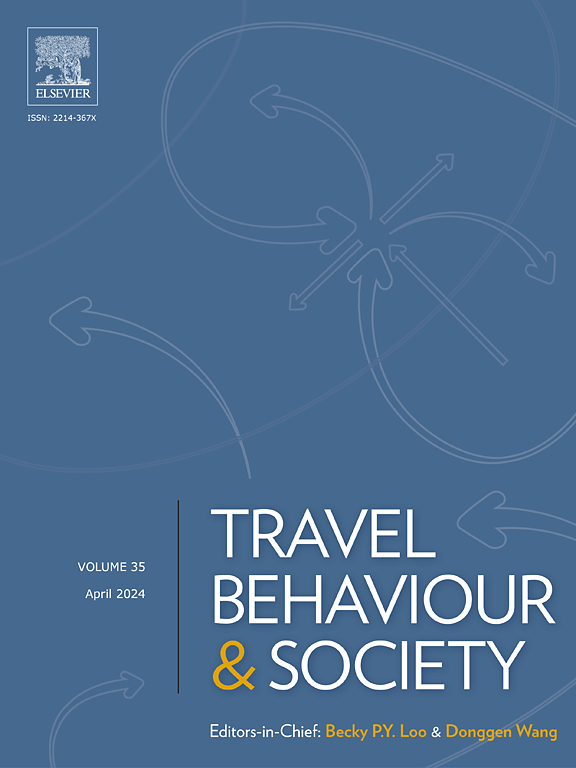Impact of attitude, behaviour and opinion of e-scooter and e-bike riders on collision risk in Singapore
IF 5.1
2区 工程技术
Q1 TRANSPORTATION
引用次数: 0
Abstract
Active Mobility Devices (AMDs) such as electric scooters (e-scooters) and electric bikes (e-bikes) are increasingly used on shared paths and Park Connector Networks (PCNs) in Singapore, leading to frequent interactions between AMD riders, pedestrians, and cyclists. To ensure safety, it is crucial to understand the factors associated with collision risk related to these AMDs. To gain insights into the riders’ perspectives on the risk-taking behaviours and attitudes towards safety and sharing paths, a survey was conducted with 369 e-bike and 133 e-scooter riders across Singapore. The collected data was analysed to identify critical features of behaviour, attitudes, and opinions of e-scooters/e-bikes riders and their impact on perceived collision risk. Logistic Regression was used to select the most important behavioural features linked to collision risk, and significance of each was quantified by using the odds ratios in the chosen model. The results reveal that e-bike riders who regularly brake hard to avoid obstacles and highly value capacity of e-bike to carry goods face an increase in collision risk by 49.1% and 43.48% respectively. Those preferring quieter AMDs face 33.31% lower collision risk. Additionally, e-bike riders advocating for more traffic enforcement or the importance of slowing down when overtaking pedestrians face 20.69% and 38.84% lower collision risk respectively. E-scooter riders who manoeuvre quickly to dodge collisions or prioritize passenger-carrying capacity encounter a 142.25% and 67.43% higher collision risk, respectively. Furthermore, e-scooter riders willing to bend rules when not causing inconvenience to others face an increase in collision risk by 123.00%. These outcomes offer significant insights for the design and regulation of active mobility to safeguard all road users in a multi-modal transport environment.
新加坡电动摩托车和电动自行车骑手的态度、行为和观点对碰撞风险的影响
在新加坡,电动滑板车(e-scooters)和电动自行车(e-bikes)等主动式移动设备(AMDs)越来越多地在共享道路和公园连接网络(PCNs)上使用,导致AMDs骑行者、行人和骑自行车者之间的频繁互动。为确保安全,了解与 AMD 相关的碰撞风险因素至关重要。为了深入了解骑行者对冒险行为的看法以及对安全和共用道路的态度,我们在新加坡对 369 名电动自行车骑行者和 133 名电动滑板车骑行者进行了调查。对收集到的数据进行了分析,以确定电动摩托车/电动自行车骑行者的行为、态度和观点的关键特征及其对感知碰撞风险的影响。采用逻辑回归法选出与碰撞风险相关的最重要的行为特征,并利用所选模型中的几率比对每个特征的重要性进行量化。结果显示,经常急刹车以避开障碍物的电动自行车骑行者和非常重视电动自行车载货能力的骑行者面临的碰撞风险分别增加了 49.1%和 43.48%。而喜欢较安静的 AMD 的骑行者的碰撞风险则降低了 33.31%。此外,主张加强交通执法或在超越行人时减速的电动自行车骑行者的碰撞风险分别降低了 20.69% 和 38.84%。为躲避碰撞而快速操纵电动摩托车或优先考虑载客量的电动摩托车骑行者的碰撞风险分别高出 142.25% 和 67.43%。此外,在不给他人造成不便的情况下,愿意遵守规则的电动滑板车骑行者面临的碰撞风险增加了 123.00%。这些结果为主动交通的设计和监管提供了重要启示,以保障多模式交通环境中所有道路使用者的安全。
本文章由计算机程序翻译,如有差异,请以英文原文为准。
求助全文
约1分钟内获得全文
求助全文
来源期刊

Travel Behaviour and Society
TRANSPORTATION-
CiteScore
9.80
自引率
7.70%
发文量
109
期刊介绍:
Travel Behaviour and Society is an interdisciplinary journal publishing high-quality original papers which report leading edge research in theories, methodologies and applications concerning transportation issues and challenges which involve the social and spatial dimensions. In particular, it provides a discussion forum for major research in travel behaviour, transportation infrastructure, transportation and environmental issues, mobility and social sustainability, transportation geographic information systems (TGIS), transportation and quality of life, transportation data collection and analysis, etc.
 求助内容:
求助内容: 应助结果提醒方式:
应助结果提醒方式:


